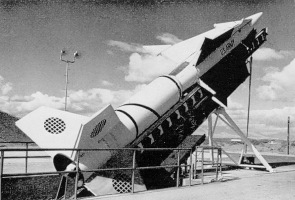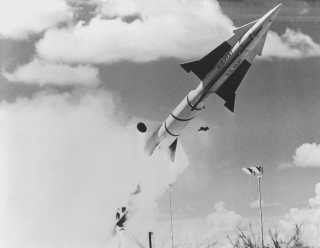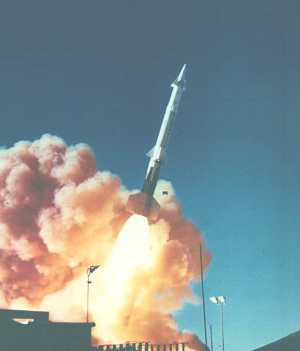Nike Zeus
The Nike Zeus missile has a very interesting history. Two major
versions of it are known, with a third version produced for ASAT
duties. The same missile was further developed, but was renamed as
Spartan as the radars and deployment changed during the 1960s.
Nike Zeus A
 The Nike Zeus A is
aerodynamically very similar to the Nike Hercules, just scaled up.
However, the Nike Zeus A was designed for a very different mission
- it was designed to perform an interception of ballistic missile
RVs at high altitude. Like Nike Hercules, it was a two stage
missile but instead of using the Nike Ajax booster, a new booster
was used which was the largest single chamber solid rocket motor
produced in the US at that time delivering over 450 000lb of
thrust.
The Nike Zeus A is
aerodynamically very similar to the Nike Hercules, just scaled up.
However, the Nike Zeus A was designed for a very different mission
- it was designed to perform an interception of ballistic missile
RVs at high altitude. Like Nike Hercules, it was a two stage
missile but instead of using the Nike Ajax booster, a new booster
was used which was the largest single chamber solid rocket motor
produced in the US at that time delivering over 450 000lb of
thrust.
The Nike Zeus A had a very short life as it only had a small
number of launchers before being replaced by the Nike Zeus B. As a
result, some sources claim that this was infact a flight test
article for the booster and not actually a Nike Zeus missile at
all. I find this hard to understand as the 2nd stage is new, or at
least the fins have been redesigned (especially when comparing it
to a Nike Hercules), indicating some design work had taken place
for this missile.
The capability of the missile was constrained by the 200 mile
range restriction that was issued by Secretary of Defence Wilson in
28 November 1956. This restriction was rescinded 12 months later
once Sputnik 1 had orbited the earth. This then allowed the US Army
to then develop the Nike Zeus B which overcame some of the
limitations already present and known in the Nike Zeus A.
Launch History
All launches took place at White Sands Missile Range.

| # |
Date |
Comment |
| 1 |
26 August 1959 |
Fist stage only was live. Exploded shortly after launch. |
| 2 |
14 October 1959 |
First stage only was live. Successful. |
| 3 |
16 December 1959 |
Both stages live. Failed. |
| 4 |
3 February 1960 |
Successful. |
| 5 |
9 March 1960 |
Full Range test. Successful. |
| 6 |
25 May 1960 |
Successful. |
Specifications
| Length: |
13.28m (44ft 3in) |
| Diameter: |
0.91m (3ft) |
| Span: |
3m (9ft 9.6in) |
| Weight: |
5,000kg (11,000lb) |
| Range: |
320km (200 miles) |
| 1st Stage Motor: |
Thiokol TX-135 450,000lb thrust |
| 2nd Stage Motor: |
Thiokol |
| Guidance: |
Radio command |
| Warhead: |
Nuclear, 20kt |
Nike Zeus B was a far more capable missile than the A version
due to a number of factors. It had a greater range, it was a three
stage missile and it was designed to intercept targets outside the
atmosphere. The main reason for this missile being developed was
due to the dropping of the range restriction that had been imposed
during 1956/7. By increasing the range, the missile could defend a
much larger area which meant that fewer installations were required
which provided some cost savings while still maintaining a
defence.

The first stage was the same as that of Zeus A, but everything
after that was new. The second stage had a slightly smaller
diameter than the booster, while the third stage was slightly
smaller again. The large aerodynamic fins that were so prominent on the Zeus A
sustainer were gone, and replaced with small vanes at the top of
the missile which provided some control while in the atmosphere.
Once the missile had left the atmosphere control was obtained
through the 3rd stage motor. Target destruction was obtained
through the use of a nuclear warhead. This warhead was tested
during 1962 at Christmas Island in the Pacific Ocean.
With the Nike-X ABM system, studies
went into an extended range version of the Zeus B, and that missile
was called Nike Zeus EX. It was renamed as Spartan when Nike-X was renamed as Sentinel in 1967.
Launch History
Due to the improved performance of the missile, it was no longer possible to
test the missile at full range at White Sands. The Naval Test Range at Point Mugu
was upgraded with the necessary radars and equipment to allow launches to take
place there. However, Pt Mugu also proved unsatisfactory due to range safety
restrictions which caused a number of good missiles to being destroyed early
in their flights.
Suitable sites were then investigated in the Atlantic Range area, but due to the
sensitive nature of the missile firings, using foreign countries for the testing was
deemed unacceptable. Attention then shifted to the Pacific, and Kwajalein was chosen.
On February 12, 1959 the DoD aproved a test program for Nike Zeus which used
Kwajalein as the launch site for the missile.

| # |
Date |
Comment |
| 1 |
28 April 1960 |
Only 1st stage was live. Successful. |
|
|
|
| Testing of two stage versions completed
in summer of 1961. |
|
9 September 1961 |
First 3 stage flight. Tested from Point Mugu Naval
Station. |
|
14 December 1961 |
Nike Zeus intercepts a Nike Hercules missile at WSMR. |
|
19 July 1962 |
Intercepted an Atlas D RV. Zeus launched from
Kwajalein, Atlas from Vandenberg. Passed within 2km of RV. |
|
22(12?) December 1962 |
Nike Zeus intercepted an RV (Atlas D from Vandenberg?) and passed within 22
metres. |
|
End 1963 |
A total of 13 RVs had technically been destroyed.
Number of launches is unknown. |
Specifications
| Length: |
14.73m (48ft 4in) |
| Diameter: |
0.91m (3ft) |
| Span: |
2.44m (8ft) |
| Weight: |
10,350kg (22 800lb) |
| Range: |
400km (250 miles) |
| Ceiling: |
280km (174 miles) - altitude obtained during ASAT test |
| 1st Stage Motor: |
Thiokol TX-135, 450,000lb thrust |
| 2nd Stage Motor: |
Thiokol TX-238 |
| 3rd Stage Motor: |
Thiokol TX-239 |
| Guidance: |
Radio command |
| Warhead: |
W-50 Thermonuclear, 400kt |
In April/May 1962 Defence Secretary McNamara agreed to a US Army
request to reorient the Nike Zeus missile into an anti-satellite
program. This program was called Project 505 with a code name of
"Mudflap".
To achieve this, a modified Nike Zeus missile was developed designated
DM-15S. To allow the high altitude, long rage interception,
a number of changes were made to the missile. These changes included a two stage
hydraulic pump, a higher performing booster propellant and a longer life battery (5 minutes
instead of 2).
A modified DM-15B was tested at White Sands
in December 1962 and successfully intercepted a fix point in space at 100 nautical
mile altitude. A DM-15S was launched on 15 February 1963 and it intercepted
a fix point in space at an altitude of 151 nautical miles.
The first attempted interception of a simulated satellite took place on 21 March 1963 at an
altitude of 112 nautical miles. The MTR failed to track the missile and the launch was considered
a failure. Success was finally achieved on 24 May 1963 against a real target. An Agena D,
which had special instruments installed to measure the miss distance, was tracked and
intercepted by a DM-15S.
On 27 June 1963 McNamara
ordered that a Nike Zeus missile be kept ready at all times at
Kwajalein complete with a live nuclear warhead. The US thus had an
operational ASAT capability. Although not directly related to the
Nike Zeus, the US Air Force had also deployed in the ASAT role Thor
IRBMs which were based at Johnston Island. Despite performing the
same mission, the two missiles complemented each other. The Nike
Zeus was a faster reacting missile, but was limited by its range.
The Thor was a slower reacting missile due to its liquid
propellants (and during the last part of its life as an ASAT
missile, its reaction time was measured in weeks), but Thor had a
much greater range. McNamara eventually believed that the two ASATs
competed with each other and only one should be deployed. Thus in
May 1966, Program 505 was declared redundant and it was directed to
shut down thus leaving the Thors to perform the ASAT role.
On a side note, Hurricane Celeste caused extensive damage to the
facilities for the Thor ASATs in August 1972 and repairs were made.
Once put back on active service, it was found that the damage was
more extensive than original thought and in December 1972 the Thors
were phased out from operational use.
Launch History
| Launch # |
Date |
Location |
Comment |
| 1 |
17 December 1962 |
White Sands |
Success. Intercepted point in space at 100nm altitude. |
| 2 |
15 February 1963 |
White Sands |
Success. Intercepted point in space at 151nm altitude. |
| 3 |
21 March 1963 |
Kwajalein |
Failure. MTR failed to track the missile. |
| 4 |
19 April 1963 |
Kwajalein |
Failure. Beacon loss at 30sec before intercept. |
| 5 |
24 May 1963 |
Kwajalein |
Success. Target was a specially instrumented Agena D. |
| 6 |
6 January 1964 |
Kwajalein |
Success - this was against a simulated satellite at 93 nautical
mile range and at an altitude of 79 nautical miles. |
| 7 |
?? April 1964 |
Kwajalein |
Success - this was to test communications with the missile,
exo-atmospheric beam intercept and exit altitude control. |
| 8 |
?? June 1965 |
Kwajalein |
Success |
| 9 |
?? June 1965 |
Kwajalein |
Success |
| 10 |
?? July 1965 |
Kwajalein |
Success |
| 11 |
?? July 1965 |
Kwajalein |
Failure |
| 12 |
13 January 1966 |
Kwajalein |
Success - this was launched by an operational missile
crew. |
Last Modified: 3-Feb-2012
 The Nike Zeus A is
aerodynamically very similar to the Nike Hercules, just scaled up.
However, the Nike Zeus A was designed for a very different mission
- it was designed to perform an interception of ballistic missile
RVs at high altitude. Like Nike Hercules, it was a two stage
missile but instead of using the Nike Ajax booster, a new booster
was used which was the largest single chamber solid rocket motor
produced in the US at that time delivering over 450 000lb of
thrust.
The Nike Zeus A is
aerodynamically very similar to the Nike Hercules, just scaled up.
However, the Nike Zeus A was designed for a very different mission
- it was designed to perform an interception of ballistic missile
RVs at high altitude. Like Nike Hercules, it was a two stage
missile but instead of using the Nike Ajax booster, a new booster
was used which was the largest single chamber solid rocket motor
produced in the US at that time delivering over 450 000lb of
thrust.

